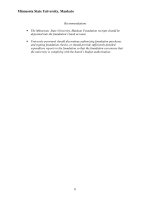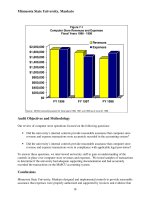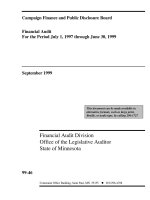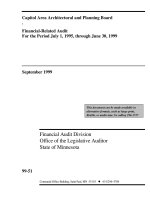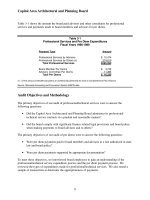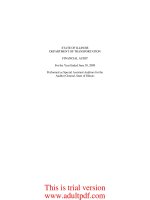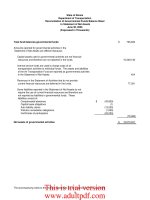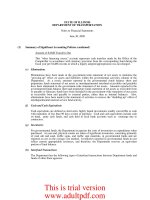Department of Revenue Financial Audit For the Period July 1, 1996, through March 31, 1999 October 1999_part2 pptx
Bạn đang xem bản rút gọn của tài liệu. Xem và tải ngay bản đầy đủ của tài liệu tại đây (984.35 KB, 11 trang )
Automobile Theft Prevention Board
8
reimbursed up to the grant award amount based on actual expenditures reported on a quarterly
basis. After completion of the program, subgrantees are required to report program results to the
board in objective terms (such as the number of vehicles recovered, criminals prosecuted, or
training seminars held). The board uses this information to evaluate the level of success of the
grant program.
The Board of Directors’ philosophy is to award grant funding that will establish or enhance a
comprehensive program to combat auto theft. A comprehensive program includes efforts in
education and training strategies, pro-active strategies, and prosecution and investigation
strategies. Figure 3-2 shows the financial resources awarded by category as of February 1999.
Education /
Training
Strategies
32% ($979,936)
Prosecution /
Investigation
Strategies
26% ($778,516)
Pro-Active
Strategies
42%
($1,273,866)
Source: The Board's February 1999 report to the Legislature.
Figure 3-2
Grant Awards by Strategy
Audit Objectives and Methodology
Our audit of the grant process focused on answering the following questions:
• Did the board have an appropriate process for awarding grant funds and ensuring
compliance with applicable legal provisions and board policies?
• Did the board accurately record grant awards and grant expenditures on the state’s
accounting system?
To answer these questions, we interviewed the board chair as well as employees of the
Department of Public Safety’s Administration Division to gain an understanding of the controls
over the grant award and disbursement processes. We reviewed supporting documentation used
by the board to disburse and monitor grants.
Automobile Theft Prevention Board
9
Conclusions
The Automobile Theft Prevention Board accurately recorded its grant expenditures on the state’s
accounting system. However, the board did not have a process to ensure that it did not create
potential conflicts of interest for members. This issue is discussed in Finding 2. In addition, the
board did not have adequate controls when issuing state warrants to local organizations, as
discussed in Finding 3.
2. The Automobile Theft Prevention Board did not have a process to ensure that it did not
create potential conflicts of interest for its members.
The board did not have a conflict of interest policy to guide its membership when approving
grant awards to constituent organizations. The board minutes did not adequately document
board members’ voting records. Therefore, we could not determine whether board members
abstained from voting on grants to related organizations. For example, the board minutes for
February 19, 1998, approved a grant of $108,610 to the Duluth Police Department. The board
meeting minutes identify that three board members were present, including the representative of
the Duluth Police Department. The board by-laws require four persons for a quorum. Even
though the required quorum was not present, the board approved nine grants at the meeting.
Because the board minutes did not document each board members’ vote, we were not able to
determine whether the board member representing the Duluth Police Department abstained from
voting on the grant to that organization. We identified two other instances when potential
conflicts of interest occurred. In one case, a board member from the St. Paul Police Department
was present at a meeting where grants totaling $95,090 to that agency were approved. In another
instance, Mr. Roske, the board chair, was present at a meeting where a $139,347 grant to a
nonprofit organization, the Anti-Vehicle Crime Association of Minnesota, was approved. Mr.
Roske also served on the board of the nonprofit organization. There was no documentation that
these board members abstained from voting on grants to organizations with which they were
affiliated.
The board did not act independently when it granted funds to the Department of Public Safety.
Mr. Roske was involved in completing and submitting grant applications on behalf of the
Department of Public Safety. For example, in July 1997, Mr. Roske submitted a grant
application for funding of a fiber optic camera used to identify stolen vehicles. The board
awarded the $7,800 grant and the Department of Public Safety purchased the camera. Although
the department owns the camera, the board, in its investigations, was the primary user. We do
not believe it was appropriate for the board chair to act on behalf of the Department of Public
Safety in preparing and submitting grant applications. Grants submitted in this manner may have
a greater chance of being approved than similar grants submitted by another agency. In addition,
it is unclear why a grant was awarded to the department to purchase a camera to be used by the
board.
In another example, the board authorized a grant of $40,000 to the Department of Public Safety
for equipment that had already been purchased by the department. On August 7, 1997, the
Department of Public Safety’s Bureau of Criminal Apprehension submitted a $110,000 grant
application for a gas chromatography/mass spectrometer. The board originally denied the
request. The Department of Public Safety purchased it anyway, and on May 13, 1998, the
bureau resubmitted a grant request for $40,000 to pay in part for the gas chromatography/mass
Automobile Theft Prevention Board
10
spectrometer. The board approved the $40,000 grant award. State accounting records show that
the bureau had actually paid for the equipment on May 5, 1998, prior to receiving the grant
award. The grant contract between the board and the bureau was finalized on June 25, 1998. In
effect, the $40,000 grant augmented funding available in the bureau’s budget. Financing this
equipment through the use of board funds did not increase the state’s overall effort in preventing
auto theft.
Recommendations
• The board should develop a conflict of interest policy and process to ensure
that board members abstain from voting on grants to their constituent
organizations.
• The board should ensure that its meeting minutes accurately and completely
document actions taken.
• The board should ensure that a quorum is present before conducting official
business.
3. The board did not properly establish controls when issuing state warrants to local
organizations.
The board did not have an adequate separation of duties when issuing state warrants to local
organizations. The board initiated payments to local organizations through the state’s accounting
system. The Department of Finance produced state warrants for payments to the local
organizations. However, the board requested Finance to pull the warrants and forward them to
the board office for distribution with a special cover letter. To establish effective controls,
individuals with the ability to authorize payments should not have physical access to the state
warrants. As a general practice, warrants should be issued directly by the Department of Finance
to the local organizations.
Recommendation
• Board staff should no longer physically handle state warrants.
Automobile Theft Prevention Board
11
Chapter 4. Automobile Theft Prevention Insurance Surcharge
Revenues
Chapter Conclusions
For the items tested, revenue collections complied with applicable legal
provisions and board policies. In addition, the board accurately and properly
recorded all of the collected revenues on the state’s accounting system.
Background
Each insurer engaged in the writing of automobile insurance policies is required by law to collect
a surcharge, at the rate of 50 cents per vehicle for every six months of automobile insurance
issued or renewed in Minnesota. Insurance companies are required to remit the revenue derived
from this surcharge at least quarterly to the board for purposes of the automobile theft prevention
program. A special revenue account in the state treasury is credited with the surcharge proceeds.
The board has entered into an interagency agreement with the Department of Revenue to manage
the collection of the proceeds on behalf of the board. The Department of Revenue provides each
insurance issuer with the necessary information and forms to facilitate the insurance provider’s
compliance with the law. Revenue collections during fiscal years 1997 and 1998 totaled
$4,230,017.
Audit Objectives and Methodology
Our audit of the revenue collection process focused on answering the following questions:
• Did revenue collections comply with applicable legal provisions and board policies?
• Did the board accurately record all of the collected revenues on the state’s accounting
system?
To answer these questions, we interviewed the board chair as well as employees of the
Department of Revenue’s Special Taxes Division to gain an understanding of the department’s
relationship with the board. We reviewed the interagency agreement between the board and the
Department of Revenue. We tested the Department of Revenue’s Special Taxes Division
process used to deposit collected revenues in the state treasury and to record the collected
revenues in the state’s accounting system.
Conclusions
For the items tested, revenue collections complied with applicable legal provisions and
board policies. In addition, the board accurately recorded collected revenues on the
state’s accounting system.
Automobile Theft Prevention Board
12
This page intentionally left blank.
Automobile Theft Prevention Board
13
Chapter 5. Payroll and Administrative Expenditures
Chapter Conclusions
The Automobile Theft Prevention Board properly recorded payroll and
administrative expenditures on the state’s accounting system. The board
complied with material finance-related legal provisions for the items tested.
However, the board did not provide proper oversight for overtime earned by the
executive director, as discussed in Chapter 2.
Background
The board had one employee who served as the board’s chair, executive director, and auto theft
investigator and one clerical employee during the audit period. In addition, the Department of
Public Safety provided other administrative support to the board.
Audit Objectives and Methodology
Our audit of payroll and administrative expenditures focused on answering the following
questions:
• Did payroll and administrative expenditures comply with applicable legal provisions and
board policies?
• Did the board accurately record payroll and administrative expenditures on the state’s
accounting system?
To answer these questions, we interviewed the chair of the board and employees of the
Department of Public Safety’s Administration and Human Resources Divisions to gain an
understanding of controls over the board’s disbursement process. We reviewed the supporting
documentation for a sample of administrative expenditures. We reviewed employee pay rates to
determine if the board complied with statutory provisions and bargaining agreements. Finally,
we performed various analytical procedures to determine the reasonableness of the board's
payroll and administrative expenditures.
Conclusions
The Automobile Theft Prevention Board properly recorded payroll and administrative
expenditures on the state’s accounting system. The board complied with material finance-related
legal provisions for the items tested. However, the board did not provide proper oversight of
overtime earned by the executive director, as discussed in Chapter 2.
Automobile Theft Prevention Board
14
This page intentionally left blank.

